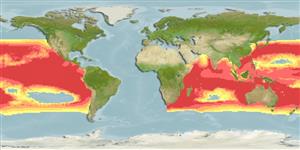Actinopterygii (ray-finned fishes) >
Perciformes (Perch-likes) >
Istiophoridae (Billfishes)
Etymology: Tetrapturus: Greek, tetra = four + Greek, pteron, fin, wing (Ref. 45335). More on author: Tanaka.
Environment / Climate / Range
Ecology
Marine; pelagic-oceanic; oceanodromous (Ref. 51243); depth range 0 - 1830 m (Ref. 86942), usually 0 - 350 m (Ref. 89423). Subtropical, preferred 28°C (Ref. 107945); 43°N - 56°S, 20°E - 68°W
Indian and Pacific: tropical and temperate waters. Although some stray individuals are found in the Atlantic Ocean, this species is believed to have its spawning grounds and principal populations only in the Pacific and Indian Oceans. Highly migratory species, Annex I of the 1982 Convention on the Law of the Sea (Ref. 26139).
Size / Weight / Age
Maturity: Lm ? range ? - ? cm
Max length : 230 cm TL male/unsexed; (Ref. 9308); common length : 190 cm TL male/unsexed; (Ref. 9308); max. published weight: 52.0 kg (Ref. 43)
Dorsal
spines
(total): 0;
Dorsal
soft rays
(total): 51-57;
Anal
spines: 0;
Anal
soft rays: 18 - 23. Dark blue above, blue splattered with brown on the sides, silvery white below; 1st dorsal fin plain dark blue, other fins brown or dark brown; anal fin bases with tinges of silvery white.
Oceanic and epipelagic, found above the thermocline (Ref. 9308). Feeds on fishes, cephalopods and crustaceans. Also caught as a by-catch of long lines with hooks intended for tuna. Marketed frozen and prepared as fish cakes and sashimi in Japan (Ref. 9308). Also prepared as sausages.
Life cycle and mating behavior
Maturity | Reproduction | Spawning | Eggs | Fecundity | Larvae
Spawning is believed to occur mainly during the winter months, especially in warm offshore currents with surface temperature of about 25°C.
Nakamura, I., 1985. FAO species catalogue. Vol. 5. Billfishes of the world. An annotated and illustrated catalogue of marlins, sailfishes, spearfishes and swordfishes known to date. FAO Fish. Synop. 125(5):65p. Rome: FAO. (Ref. 43)
IUCN Red List Status (Ref. 115185)
CITES (Ref. 94142)
Not Evaluated
Threat to humans
Harmless
Human uses
Fisheries: minor commercial; gamefish: yes
More information
ReferencesAquacultureAquaculture profileStrainsGeneticsAllele frequenciesHeritabilityDiseasesProcessingMass conversion
Tools
Special reports
Download XML
Internet sources
